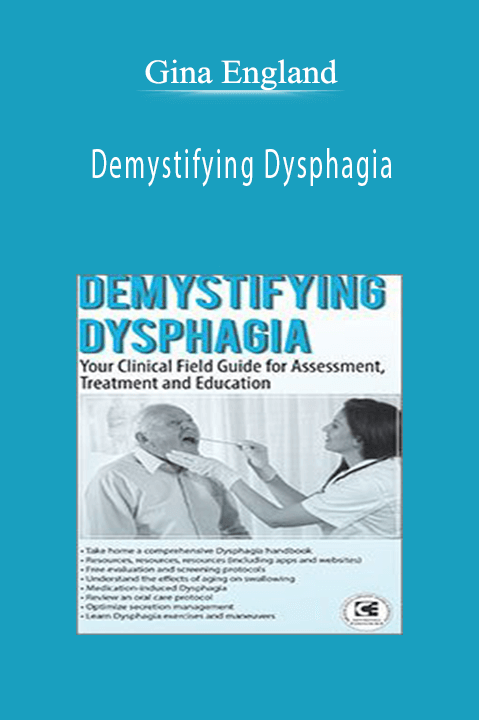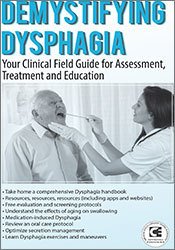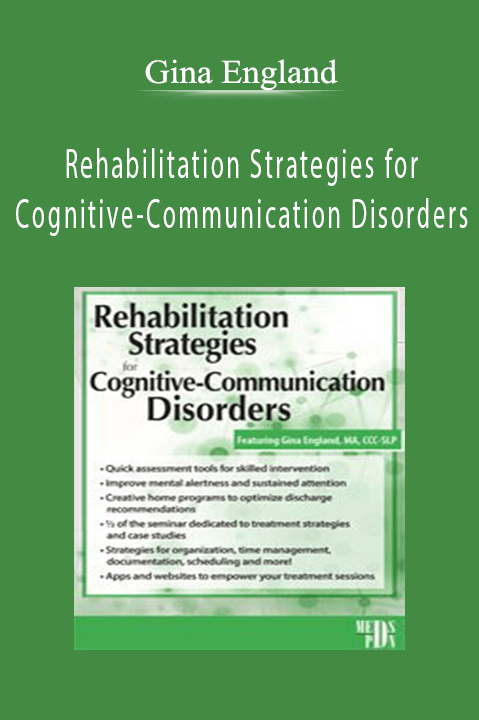Demystifying Dysphagia: Your Clinical Field Guide for Assessment, Treatment and Education – Gina England
- Take home a comprehensive Dysphagia handbook
- Resources, resources, resources (including apps and websites)
- Free evaluation and screening protocols
- Understand the effects of aging on swallowing
- Medication-induced Dysphagia
- Review an oral care protocol
- Optimize secretion management
- Learn Dysphagia exercises and maneuvers
The clinical management of Dysphagia is often perceived as one of the most challenging and daunting experiences. I was recently working with a patient admitted to our hospital with a history of CVA and a recent onset of Dysphagia. The medical referral stated that he was likely aspirating because he would start coughing within minutes of beginning a meal, and speech therapy was asked to make a recommendation for a modified diet consistency. The immediate and probable presumption was aspiration because the patient had a distant history of CVA and his pulmonary status was compromised with pneumonia. I knew this patient very well and indicated the following key points in my report: he did not experience a pharyngeal stage dysphagia with his original stroke, his vocal quality was markedly different in that he was atypically hoarse and his coughing was accompanied by a distinct acidic smell in the oral cavity. Lesson learned: persistent coughing is not necessarily a symptom of aspiration related to primary swallowing. This gentleman was eventually diagnosed with Laryngopharyngeal Reflux and a treatment plan was initiated to reduce the impact of this condition on his swallowing during PO intake.
Have you seen this type of patient in your practice? Did you know what to watch for, and what his symptoms were telling you? This patient’s situation is a reminder that we all need to fully appreciate the role of the esophagus in the management of swallowing disorders. Join me for a day filled with critical skills to increase your repertoire of Dysphagia management skills and tools.
Take home a 60+ page handbook that will serve as a comprehensive field guide to the assessment and treatment of Dysphagia. A supplemental handout section of the manual will provide you with screening tools, checklists, worksheets, cheat sheets and documentation forms that can be readily incorporated into your daily clinical practice. In addition to a comprehensive review of the manual’s content, you will also benefit from actual Dysphagia videos, numerous case studies and in-class activities designed to assist in the internalization of some of the seminar’s fundamental content. Increase your clinical confidence with this highly interactive and hands-on experience!
OUTLINE
A Deeper Understanding of Dysphagia
- Swallowing misconceptions and pet peeves
- Anatomy and physiology of a swallow
- The effects of aging on the swallow
- Disorders associated with Dysphagia
- Medications that may induce Dysphagia
- Signs and symptoms
- Esophageal Dysphagia – our new frontier
Assessment and Screening Techniques
- Evaluation and Screening Tools
- The Modified Barium Swallow Study (MBSS)
- The Videofluoroscopic Swallowing Study (VFSS)
- Fiberoptic Endoscopic Evaluation of Swallowing (FEES)
- The Esophagram/Barium Swallow
- Manometers
Treatment Strategies
- The phenomena of aspiration
- Oral care protocols
- Managing oral secretions
- The maneuvers
- Tracheostomy and extubation
- Disease specific dysphagias
- The National Dysphagia Diet
- Naturally thickened liquids
The Post Script
- Dysphagia competencies
- Patient and family education
- Managing non-compliance
Technology and Resources for Therapy
- Commercially available products
- Clinical resources (apps, websites, books, etc.)
- Supplemental handouts
OBJECTIVES
- State two age-related changes to the swallowing system in the elderly.
- State three symptoms of an esophageal phase Dysphagia.
- Explain the clinical benefits of the MBS/VFSS study and the FEES examination.
- List three readily available/public domain Dysphagia screening tools.
- Describe a basic but essential oral care protocol.
- Define three primary objectives in the management of xerostomia.
- State three components of a clinical rationale supporting the initiation of a protocol for naturally thickened liquids.
- List three risk factors to consider when assessing a tracheostomy patient for PO intake.
Get Download Demystifying Dysphagia: Your Clinical Field Guide for Assessment, Treatment and Education – Gina England at Offimc.click Now!
Delivery Information
- Upon ordering the product, a delivery email with download instructions will be sent immediately to you so that you may download your files. If you log in (or create an account) prior to purchase you will also be able to access your downloads from your account dashboard.
- It is a digital download, so please download the order items and save them to your hard drive. In case the link is broken for any reason, please contact us and we will resend the new download link to you.
- If you don't receive the download link, please don’t worry about that. We will update and notify you as soon as possible from 8:00 AM – 8:00 PM (UTC+8).
- Please Contact Us if there are any further questions or concerns you may have. We are always happy to assist!









12 reviews for Gina England – Demystifying Dysphagia: Your Clinical Field Guide for Assessment, Treatment and Education
There are no reviews yet.